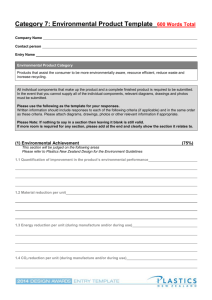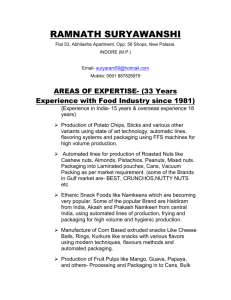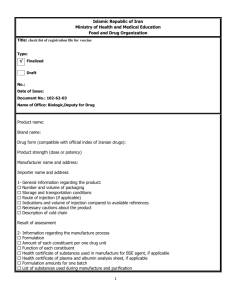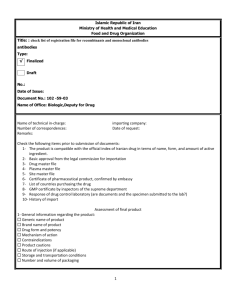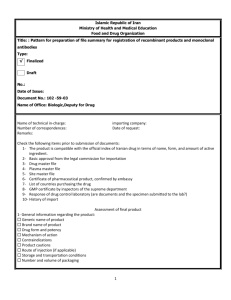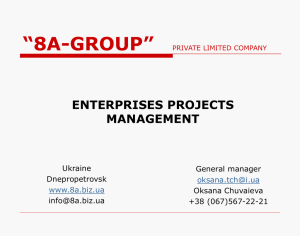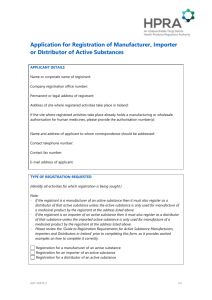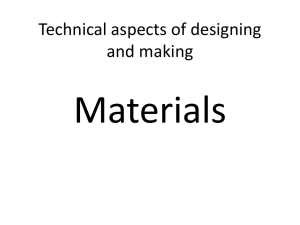SUBJECT CONTENT Revision Guide Page Exam Q WRITTEN
advertisement
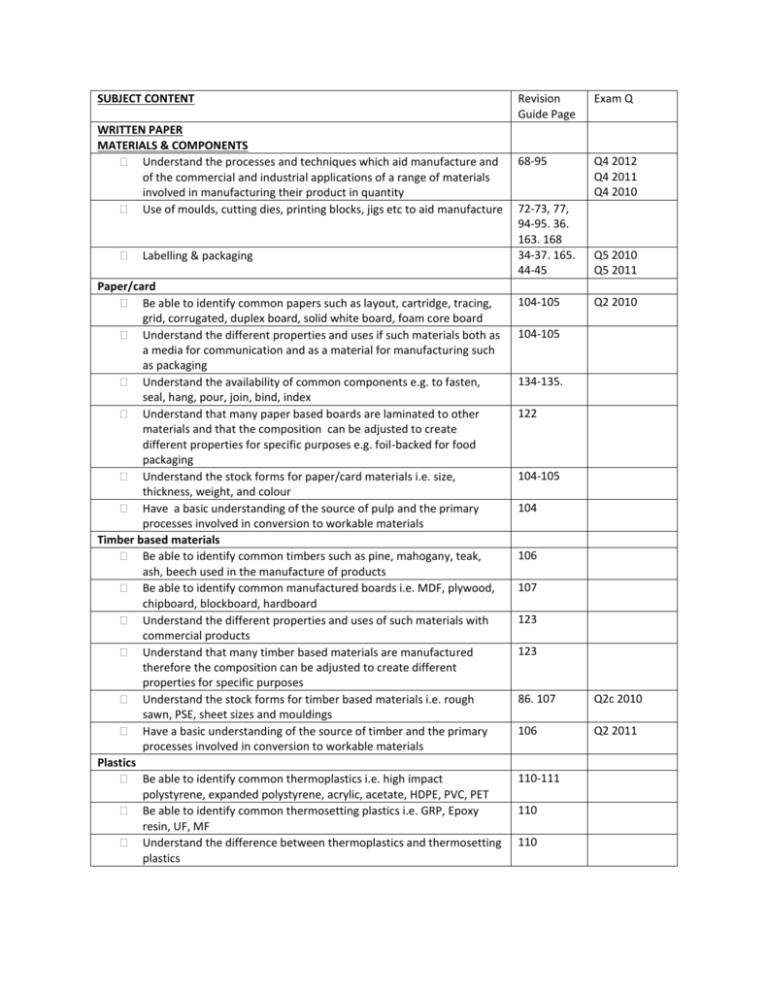
SUBJECT CONTENT WRITTEN PAPER MATERIALS & COMPONENTS Understand the processes and techniques which aid manufacture and of the commercial and industrial applications of a range of materials involved in manufacturing their product in quantity Use of moulds, cutting dies, printing blocks, jigs etc to aid manufacture Labelling & packaging Paper/card Be able to identify common papers such as layout, cartridge, tracing, grid, corrugated, duplex board, solid white board, foam core board Understand the different properties and uses if such materials both as a media for communication and as a material for manufacturing such as packaging Understand the availability of common components e.g. to fasten, seal, hang, pour, join, bind, index Understand that many paper based boards are laminated to other materials and that the composition can be adjusted to create different properties for specific purposes e.g. foil-backed for food packaging Understand the stock forms for paper/card materials i.e. size, thickness, weight, and colour Have a basic understanding of the source of pulp and the primary processes involved in conversion to workable materials Timber based materials Be able to identify common timbers such as pine, mahogany, teak, ash, beech used in the manufacture of products Be able to identify common manufactured boards i.e. MDF, plywood, chipboard, blockboard, hardboard Understand the different properties and uses of such materials with commercial products Understand that many timber based materials are manufactured therefore the composition can be adjusted to create different properties for specific purposes Understand the stock forms for timber based materials i.e. rough sawn, PSE, sheet sizes and mouldings Have a basic understanding of the source of timber and the primary processes involved in conversion to workable materials Plastics Be able to identify common thermoplastics i.e. high impact polystyrene, expanded polystyrene, acrylic, acetate, HDPE, PVC, PET Be able to identify common thermosetting plastics i.e. GRP, Epoxy resin, UF, MF Understand the difference between thermoplastics and thermosetting plastics Revision Guide Page Exam Q 68-95 Q4 2012 Q4 2011 Q4 2010 72-73, 77, 94-95. 36. 163. 168 34-37. 165. 44-45 Q5 2010 Q5 2011 104-105 Q2 2010 104-105 134-135. 122 104-105 104 106 107 123 123 86. 107 Q2c 2010 106 Q2 2011 110-111 110 110 Understand the ways in which plastics can be formed, especially with regard to consumer products, i.e. vacuum forming, injection moulding, blow moulding, line bending, compression moulding, extrusion Understand that most plastics are synthetic and that the composition can be adjusted to create different properties for specific purposes e.g. increase rigidity, reduce weight, insulation Understand the stock forms for plastic materials i.e. sheet, rod, powder, granules, foam Have a basic understanding of the source of plastics and the primary processes involved in conversion to workable materials Manipulating and Combining materials How materials can be combined and processed in order to create more useful, or desirable properties How these properties are utilised in industrial contexts How a range of materials are prepared for manufacture, allowing for waste and fine finishing About a variety of self-finishing and applied-finishing processes, and appreciate their importance for aesthetic and functional reasons To achieve optimum use of materials and components, account needs to be taken of the complex inter-relationships between materials form and manufacturing processes How pre-manufactured standard components are used to improve the effectiveness of the manufacturing process and be able to identify a small range appropriate to the material areas studied New materials Have a knowledge and understanding that the development of new and smart materials are allowing designers to meet a variety of user needs in new and exciting ways e.g.; Precious Metal Clays (PMC) used in jewellery manufacture Corn starch polymers used in packaging Thermochromic pigments used for thermal warning patches Shape memory alloys Quantum Tunnelling Composite (QTC) used to incorporate electronics into textiles Have an awareness of the importance of the development of nanomaterials and integrated electronics in the area of Design Technology Design and Market Influences Understanding of the broad perspectives of the designed world including, line shape, form, proportion, colour, movement and texture within a critical awareness of aesthetics and ergonomics Evolution of Product Design Identify ways in which products evolve over time because of developments in ideas, materials, manufacturing, processes and technologies as well because of social, political, cultural and environmental changes Have a basic knowledge and understanding of major design movements since 1900 e.g. Arts & Crafts Movement Art Nouveau Art Deco 72-74 110. 125 111 110 Q2 2011 122-126. 128-133 122-126 80-81. 9293 92-93 Q2 2010 86 128-133 Q2b 2011 129 30-31. 41. 148. 154. 170-171 Q4 2013 10-11 Q5 2010 Q5 2011 12-17 Q1 2011 Q7 2010 Bauhaus Modernism De Stijl Memphis Post Modernism Recognise that design movements and cultural influences are still influencing new product development Have a knowledge and understanding that manufacturing industries are involved in continuous improvement (CI) and this is a major influence in product evolution Have a knowledge and understanding that sometimes new products are developed because of marketing pull and sometimes because of technological push Design in Practice Product Development Respond creatively to briefs, developing their own proposals and producing specifications for products and associated services Discuss and analyse the situation/problem Know how to gather and respond to research, evaluate and select information and data to support the design and manufacture of products Consider the factors involved in the design of a product which is to be produced/manufactured in quantity Consider a wide range of users and create designs which are inclusive Determine the degree of accuracy required for the product to function as planned, taking account of critical dimensions and tolerances in determining methods of manufacture Understand how graphic techniques, ICT equipment and software, particularly CAD, can be used in a variety of ways to model aspects of design proposals and assist in making decisions Have a knowledge and understanding that design ideas are protected by law through copyright, patents and registered designs Communication and representation of ideas Range of graphical techniques, annotated, formal convention, CAD Presentation techniques to portray materials, texture, finish, such as mood boards, presentation drawing, digital photography, CAD Use line, tone, colour Formal page layout as an aid to planning and presenting information Modelling ideas and evaluating ICT to communicate, model, develop and present ideas Design Methodology The design cycle Empirical problem solving, systems approach and intuitive designing Be able to use the following as starting points Natural form, pattern, structure Geometry & maths The work of well-known designers ,craftsmen, technologists 16-17 22 Q5c 2010 18 Q5 2011 Q3 2013 155 Q1 2011 Q1 2013 140-143 142-147 168 40-43. 150. 62-65 Q7b 2011 Q1 2013 64 Q1d 2011 Q7 2011 Q1 2013 Q6 2013 Q7 2011 30-31 30-31 32-33. 146149 Q1 2013 Q1 2011 Q1b 2010 Q1 2013 Detailed product analysis Religious and cultural influences Packaging Have knowledge & understanding of materials and processes used to package products and consider environmental impact The functions of packaging PICT PD Product labelling and common symbols Product marketing Branding & advertising and the effect on consumers 36-37 34-35 34-35 38-39 Q3 2011 Q 4 2013 Q3b 2011 42 43 43 Q5 2012 Q6 2012 Q6 2010 Q1 2013 Q6 2010 40-41. 150 66-67 Q5 2012 Q4 2011 Promote own products using leaflets, flyers, PoS, packaging, digital media DESIGN IN THE HUMAN CONTEXT Human Factors The difference between inclusive and exclusive design Anthropometrics and ergonomics Safety Quality 5th – 95th percentile The effects of colour eg, red for danger, yellow for warmth etc The needs of groups of users, eg, disabled, elderly, religious groups etc Manufacturing systems that use working triangles in the kitchen, production lines, assembly lines Q4 2012 Q5 2013 With regard to yourself, manufacturer and user Moral & legal responsibility Undertake simple tests to check for safety Risk assessment at all stages of designing & making Commercial methods, eg, quality circles, team working, BS EN ISO 9000 Ethical, Environmental and Sustainability How these relate to designing and making Fair trade Carbon footprint, product miles Product disposal 5Rs (re-use, recycle, repair, reduce, rethink, refuse Identify a range of ‘Green designs’ Have knowledge and understanding of main factors relating to recycling/reusing materials/products, eg, material separation, collection processing, energy costs, waste Consumer Issues The work of consumer groups eg, WHICH, internet rating sites Standards agencies (BSI, ISO) and how these affect design, manufacture & testing Legislation to protect consumers PROCESSES & MANUFACTURE Q1 2012 Q1 2013 Q6c 2012 Q5 2011 44. 150 44 44 Q6 2011 Q4 2011 50-51 Q3 2010 Q1 2013 48-49 Q5 2011 47 44-47 Q6c 2012 44 Product Manufacture How materials are cut, shaped, and formed to tolerances The difference between quality control and quality assurance Detailed working schedules eg, flow charts, production plans Industrial & commercial methods of production Scales of production, one offs, batch, mass, continuous, JIT 46 56-61. 66. 156 56-59 Work as part of a team and experience different functions within simple batch production Use CAD CAM to ensure consistency Manufacturing systems Understand that commercial manufacturing is a system or group of sub systems and the requirements that they have, eg, efficient working methods, responsibility for disposal of waste, modifications to improve usefulness of products etc Use of ICT How ICT facilitates manufacturing, JIT, video conferencing, stock control, remote manufacturing CNC, CAD/CAM greater accuracy and efficiency 62 Q2 2013 Q4c 2011 Q4 2010 Q4 2011 Q4 2011 Q4 2010 Q5 2013 Q4 2011 Q4 2010 Q7 2012 19. 49-50 59-61, 6467 Q7 2012 Q6 2013 Q7 2012


